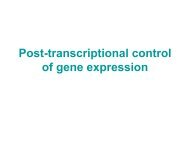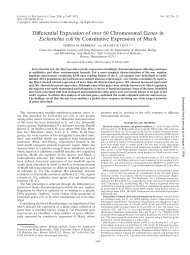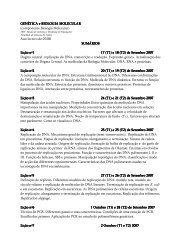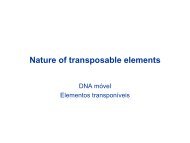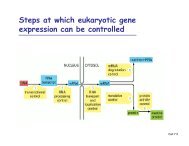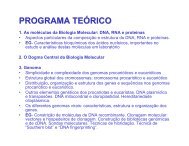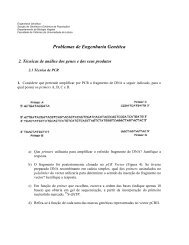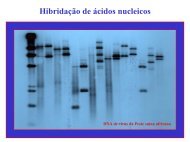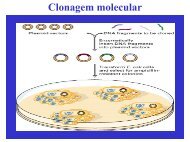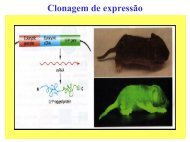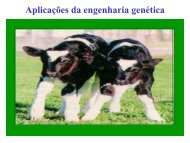The mar regulon: multiple resistance to antibiotics and other toxic ...
The mar regulon: multiple resistance to antibiotics and other toxic ...
The mar regulon: multiple resistance to antibiotics and other toxic ...
- No tags were found...
You also want an ePaper? Increase the reach of your titles
YUMPU automatically turns print PDFs into web optimized ePapers that Google loves.
R EVIEWScounterpart in Salmonella typhimurium 21 ,<strong>mar</strong>C homologs are also found inMethanococcus jannaschii, Aquifex aeolicus,Pyrococcus horikoshii, Archaeoglobusfulgidus <strong>and</strong> Treponema pallidum, <strong>and</strong> allhave unknown functions. <strong>The</strong> only knowngene homologous <strong>to</strong> E. coli <strong>mar</strong>B is thatfrom S. typhimurium 21 .(a)P<strong>mar</strong> I P<strong>mar</strong> II <strong>mar</strong>O<strong>mar</strong>C <strong>mar</strong>R <strong>mar</strong>A <strong>mar</strong>BMarR <strong>and</strong> MarA: novel transcriptionregula<strong>to</strong>rsMarR homologs are widespread amongmany different bacterial genera <strong>and</strong> someare believed <strong>to</strong> interact with differentphenolic compounds 22 . For example, the invitro activity of CinR, a MarR homologfrom Butyrivibrio fibrisolvens E14 thatnegatively regulates the expression of anenzyme involved in releasing cinnamicacids (salicylate precursors in plants) duringplant cell wall catabolism, is affected bycertain products of this metabolic pathway23 . Moreover, recent experiments havedemonstrated that many of the chemicalsthat induce <strong>mar</strong> expression in vivo antagonizethe repressor activity of MarR invitro 16 . Thus, it appears that both MarR<strong>and</strong> CinR have DNA-binding <strong>and</strong> inducerrecognitionproperties.Data pertaining <strong>to</strong> the functional regionsof MarR have begun <strong>to</strong> emerge. Pointmutations at particular residues result in a‘super-repressor’ protein that has increasedDNA-binding affinity 24 . Whether these mutationsaffect specific or non-specific DNA–protein interactions is currently unknown.Until recently, there was no biophysicalcharacterization of the DNA-binding domain(s)of any of the XylS/AraC familymembers, as these proteins are severely unstablein solution 25 . However, Rhee <strong>and</strong>coworkers recently solved the 3-D structureof a MarA–DNA co-crystal, providing the firstdirect proof for the existence of two helix-turn-helix(HTH) DNA-binding motifs 26 . Both HTH motifs inthis structure appear <strong>to</strong> participate in DNA binding<strong>and</strong> are organized in such a manner that the helicesresponsible for DNA recognition extend from thesame side of the protein. As MarA is assumed <strong>to</strong>function as a monomer 18 , this assembly allows theactiva<strong>to</strong>r <strong>to</strong> bind <strong>to</strong> one face of its target DNA 26 .(b)(c)FisFis-binding site−35 −10Site I<strong>mar</strong>ORob SoxSMarbox<strong>mar</strong>R <strong>mar</strong>A <strong>mar</strong>BSite II<strong>mar</strong>R <strong>mar</strong>A <strong>mar</strong>B<strong>mar</strong>OP<strong>mar</strong> IItrends in MicrobiologyFig. 1. Genetic organization of the Escherichia coli <strong>mar</strong> locus. (a) Expression of <strong>mar</strong>C<strong>and</strong> <strong>mar</strong>RAB is controlled by independent promoters P<strong>mar</strong> I <strong>and</strong> P<strong>mar</strong> II , respectively.MarR (144 residues) <strong>and</strong> MarA (127 residues) encode the Mar repressor <strong>and</strong> activa<strong>to</strong>r.MarB (72 residues) has an unknown function, as does MarC, a 221 amino acid,putative inner-membrane protein with <strong>multiple</strong> transmembrane-spanning helices.(b) MarR negatively regulates <strong>mar</strong>RAB expression by binding <strong>to</strong> two sites in the opera<strong>to</strong>r<strong>mar</strong>O. (c) Following inactivation of MarR, <strong>mar</strong>RAB expression is constitutive, butits level of expression depends on the interaction of MarA, Rob <strong>and</strong> SoxS (wheninduced) with a sequence (the <strong>mar</strong>box) proximal <strong>to</strong> the 35/10 hexamers. Fis playsan accessory role in this positive control 17 .agents is conferred by increased expression of cy<strong>to</strong>plasmicenzymes that counteract the damaging effectsinflicted upon the cell 30 .Inactivation of the AcrAB homolog in Haemophilusinfluenzae confers hypersusceptibility <strong>to</strong> manystructurally diverse chemicals 31 . Whether the functionof this multidrug efflux system is positivelyregulated by Ya52, the sole MarA homolog in H. influenzae32 , remains <strong>to</strong> be determined.Mechanisms of <strong>mar</strong>-mediated <strong>resistance</strong>Antibiotic <strong>resistance</strong> arises in E. coli <strong>mar</strong> mutantsboth by decreasing influx <strong>and</strong> increasing efflux of<strong>to</strong>xic chemicals from the cell. <strong>The</strong> former is accomplishedpartially by downregulating the synthesis ofOmpF (Ref. 27) <strong>and</strong>, possibly, by altering the expressionof <strong>other</strong> membrane proteins 4 . Increased efflux inboth E. coli <strong>and</strong> S. typhimurium is achieved pri<strong>mar</strong>ilyby increased synthesis of the AcrAB–TolC multidrugefflux system 4,28,29 . Resistance <strong>to</strong> oxidative stressAn array of <strong>resistance</strong> phenotypes<strong>The</strong> <strong>mar</strong> locus was originally identified by its ability<strong>to</strong> confer <strong>multiple</strong> antibiotic <strong>resistance</strong> 2 . <strong>mar</strong> mutantsshow enhanced saturable active efflux of tetracycline<strong>and</strong> chloramphenicol 2,33 . <strong>The</strong>se findings were extendedwith the discovery that expression of the AcrAB effluxsystem 28 , in addition <strong>to</strong> putative drug-specificefflux pumps 10 , was increased in <strong>mar</strong> mutants <strong>and</strong>that its removal led <strong>to</strong> increased susceptibility <strong>to</strong>tetracycline, norfloxacin, chloramphenicol, ampicillin,TRENDS IN MICROBIOLOGY 411VOL. 7 NO. 10 OCTOBER 1999



